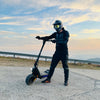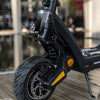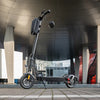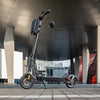How to Ride an Electric Scooter Safely in the Rain
Rainy weather doesn’t have to mean canceling your ride. If you rely on your electric scooter for daily commuting, knowing how to ride safely in wet conditions is essential. But it’s not just about staying dry—it’s about staying safe, visible, and in control.
Here's your complete guide on how to ride an electric scooter safely in the rain, featuring tips and scooter features that truly make a difference.
1. Check Your Scooter's Water Resistance
Not all scooters are built for rain. Always check the IP rating (Ingress Protection):
IPX4 = Resistant to splashes
IPX5–IPX6 = Handles stronger spray from all angles
IPX7+ = Can withstand brief submersion (rare in scooters)
GTXR models like the GTXR DT06 and GTXR S9 Pro feature IP-rated builds that allow safe riding in light to moderate rain.
2. Use the Right Tires
Wet roads are slippery. You’ll need:
Wider tires for increased grip
Pneumatic (air-filled) tires for shock absorption and surface contact
Treaded designs to channel water away from the contact point
GTXR scooters are equipped with durable tires ready for various road conditions.
3. Improve Visibility
You can’t trust drivers to see you in low-visibility weather. Enhance your presence by:
Wearing bright or reflective clothing
Using a helmet with built-in lights
Ensuring your scooter’s front and rear LED lights are on
4. Ride Slower and Brake Early
Water affects both acceleration and stopping. Always:
Reduce your speed by 30–40% in wet conditions
Brake early and gradually
Avoid sharp turns, sudden braking, or acceleration
5. After-Ride Care
Water can shorten your scooter’s lifespan if not dried properly:
Wipe down your scooter, especially around joints and display areas
Store it indoors in a dry environment
Avoid charging it while wet
Conclusion: Rainy commutes don’t have to be dangerous. With the right gear, technique, and a waterproof-ready scooter from GTXR, you can ride confidently—rain or shine.





